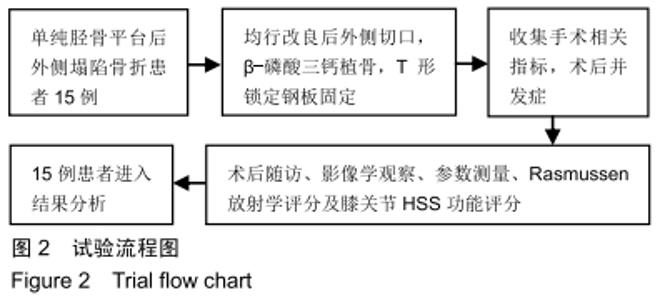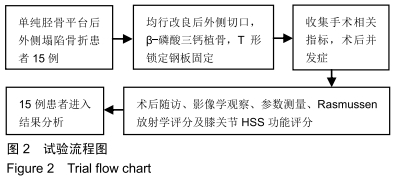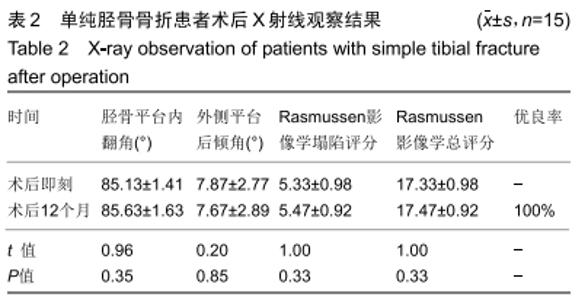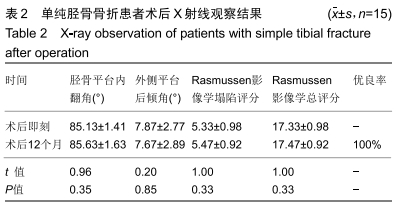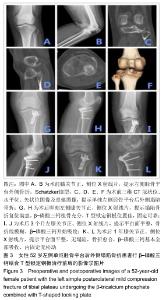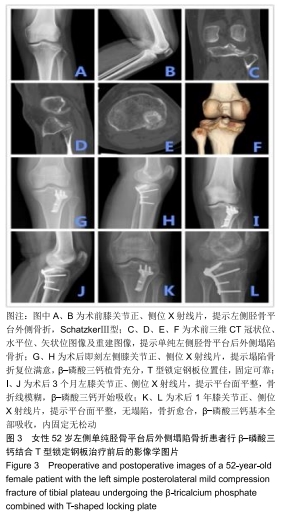[1] PARTENHEIMER A, GÖSLING T, MΫLLER M, et al. Management of bicondylar fractures of the tibial plateau with unilateral fixed-angle platefixation.Unfallchirurg.2007;110: 675-683.
[2] KENNETH AE.Split Depression Posterolateral Tibial Plateau Fracture:Direct Open Reduction and Internal Fixation.Tech Knee Surg.2005;4:257-263.
[3] KANDEMIR U, MACLEAN J.Surgical approaches for tibial plateau fractures.J Knee Surg.2014;27(1):21-29.
[4] 陈星佐,林朋,刘成刚,等.关节镜辅助复位内固定治疗胫骨平台骨折的研究进展[J].中华创伤骨科杂志,2014,16(7):622-624.
[5] BELAID D, VENDEUVRE T, BOUCHOUCHA A, et al.Utility of cement injection to stabilize split-depression tibial plateau fracture by minimally invasive methods:A finite element analysis. Clin Biomech(Bristol, Avon).2018;56:27-35.
[6] 中华创伤骨科杂志编辑委员会.胫骨平台骨折诊断与治疗的专家共识[J].中华创伤骨科杂志,2015,17(1):3-7.
[7] RASMUSSEN PS.Tibial condyIar fractures. Impairment of knee joint stability as an indication for surgical treatment.J Bone Joint Surg Am.1973;55(7):1331-1350.
[8] INSALL JN, DORR LD, SCOTT RD, et al. Rationale of the Knee society clinical rating system.Clin 0rthop Relat Res. 1989;(248):13-14.
[9] ZELTSER DW, LEOPOLD SS.Classifications in brief: Schatzker classification of tibial plateau fractures.Clin 0rthop Relat Res.2013;471(2):371-374.
[10] SOHN HS, YOON YC, CHO JW, et al.Incidence and fracture morphology of posterolateral fragments in lateral and bicondylar tibial plateau fractures.J Orth Trauma. 2015;29(2):91-97.
[11] SOLOMON LB, STEVENSON AW, KE YC, et al. Posterolateral and anterolateral approaches to unicondylar posterolateral tibial plateau fractures: A comparative study. Injury. 2013; 44(11):1561-1568.
[12] PIRES RE, GIORDANO V, WAJNSZTEJN A, et al. Complications and outcomes of the transfibular approach for posterolateral fractures 0f the tibial plateau.Injury. 2016;47(10): 2320-2325.
[13] 夏江,俞光荣,周家钤,等.经后外侧入路治疗胫骨平台后外侧骨折的解剖学研究及应用[J].中国临床解剖学杂志, 2010,28(4):369-374.
[14] ZHANG W,LUO CF,PUTNIS S,et al.Biomechanical analysis of four different fixations for the posterolateral shearing tibial plateau fracture.Knee.2012;19(2):94-98.
[15] TOHMA Y, TAKEUCHI R.Advantages of creation of holes and removal of air in artificial bone for early bone formation when used artificial bone as a gap filler in open wedge high tibial Osteotomy.Eur J Orthop Surg Traumatol.2019;29(1):131-137.
[16] SIONEK A, CZWOJDZIŃSKI A, KOWALCZEWSKI J, et al.Hip osteonecroses treated with calcium sulfate-calcium phosphate bone graft substitute have different results according to the cause of osteonecrosis: alcohol abuse or corticosteroid-induced. Int Orthop.2018;42(7):1491-1498.
[17] PAN YX, YANG GG, LI ZW, et al.Clinical observation of biomimetic mineralized collagen artificial bone putty for bone reconstruction of calcaneus fracture.Regen Biomater. 2018; 5(2):61-67.
[18] LAVERTY DP, KELLY R, ADDISON O.Survival of dental implants placed in autogenousbonegrafts and bone flaps in head and neck oncology patients: a systematic review.Int J Implant Dent.2018;4(1):19.
[19] NOGUCHI T, SARUKAWA S, TSUCHIYA Y, et al.Evaluation of postoperative changes in vascularized iliac bone grafts used for mandibular reconstruction.Int J Oral Maxillofac Surg. 2018; 47(8):990-997.
[20] KRETTEK C, CLAUSEN J, OMAR M,et al.Two-stage late reconstruction with a fresh large osteochondral shell allograft transplantation (FLOCSAT) for a large ostechondral defect in a non-union after a large tibia plateau fracture 2-year follow up.Injury.2017;48(7):1309-1318.
[21] SARIKAYA B, AYDIN HM.Collagen/Beta-Tricalcium Phosphate Based Synthetic Bone Grafts via Dehydrothermal Processing. Biomed Mater.2015;10(6):532-552.
[22] 程坚,张军,管捷,等.载纳米银磷酸三钙的体外细胞毒性及兔体内毒性[J].中国组织工程研究,2019,23(6):917-923.
[23] 罗睿,王银龙.灰度比评价奥邦骨修复材料对下颌骨缺损修复的有效性[J].中国美容医学,2018,27(3):114-117.
[24] BAYKAN E, KOC A, ESER ELCIN A, et al.Evaluation of abiomimetic poly(ε-capr olactone)/β-tricalcium phosphate multispiral scaffold for bone tissue engineering: In vitro and in vivo studies.Biointerphases.2014;9(2):029011.
[25] KOEPP HE, SCHORLEMMER S, KESSLER S, et al. Biocompatibility and osseointegration of beta-TCP: histomorphological and biomechanical studies in a weight-be aring sheep model.J Biomed Mater Res B Appl Biomater. 2004;70(2):209-217.
[26] EPSTEIN NE.Beta tricalcium phosphate: observation of use in 100 posterolateral lumbar instrumented fusions.Spine J. 2009;9(8):630-638.
[27] ASGHARZADEH SHIRAZI H, AYATOLLAHI MR, ASNAFI A, et al.To reduce the maximum stress and the stress shielding effect around a dental implant-bone interface using radial functionally graded biomaterials.Comput Methods Biomech Biomed Engin.2017;13:1-10.
[28] LIU M, NAKASAKJ M, SHIH YV, et al.Effect of age on biomaterial-mediated in situ bone tissue regeneration.Acta Biomater.2018;78:329-340.
|
